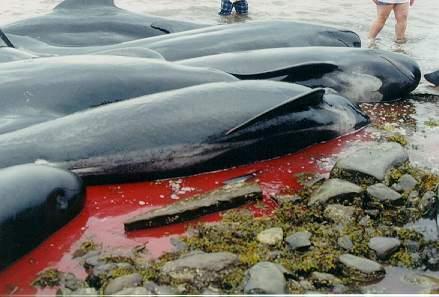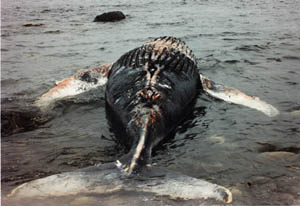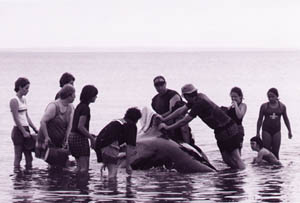TABLE OF CONTENTS |
 © Erika Toby |
INTRODUCTION
Marine mammals, particularly cetaceans (whales and dolphins) have baffled the public and the research community alike when seemingly healthy animals swim ashore and beach themselves. This behaviour often proves fatal when the tide does not pull them back to sea or there is no one on the scene to aid the animals.
To add to the mystery, some species strand by the hundreds causing mass mortality. No one knows for sure why whales and dolphins perform these fatal acts but there are several theories that have been put forth, both naturally caused and human related, in an attempt to explain this phenomenon.
WHICH CETACEANS STRAND?
All cetacean species have the potential to strand and in some cases the only information we have about rare whales is from stranded specimens. However, the toothed whales (odontocetes) tend to strand more commonly than baleen whales (mysticetes). And odontocetes are by far the most common mass stranders. Within the toothed whale group there are several species that tend to strand more commonly than others. According to Rogan et al. (1997) these are pilot whales (Globicephalus melas), white-sided dolphins (Lagenorhynchus acutus) and false killer whales (Pseudorca crassidens).
Defined by Rogan et al. (1997) a mass stranding event is two or more animals stranding alive that would die unless aided by rescue workers.The purpose of this website is not to ultimately decide on the cause of marine mammal strandings, as that is not possible. However, I do hope to outline some of the more common theories.
WHY DO WHALES AND DOLPHINS STRAND? |
 © Marine Animal Response Society |
Parasites
Upon examining animals that have stranded and died, it is often found that they are riddled with parasites. For example, a type of lungworm (Stenurus) that is commonly found moves from the nasal sinuses into the middle ear and entwines around the earbone where, as the theory goes, it impairs hearing (Dailey et al., 2000). Since whales and dolphins rely heavily on their hearing to navigate in their aquatic environment, this has the potential to be very harmful. However, most cetaceans have some level of these parasites, even those that do not routinely strand. It is difficult to know what levels of parasite infestation are critical (Dailey et al., 2000), a particular parasite may not cause any harm at one level whereas at a higher level it may cause sufficient harm to impair an animal so severely that it cannot survive. Detailed pathological examinations of carcasesare required and even then the cause of death is difficult to determine.
Biotoxins
Biotoxins have been found to contribute to the death of marine mammals (Wood and Vleet, 1996). Whether these directly or indirectly lead to stranding and death varies in different cases and depending on the biotoxin involved. In some cases single-celled algae or phytoplankton may lead to sudden deaths at sea resulting in the animals stranding already dead. The algae accumulate in the fish the whales are feeding on and bioaccumulate in the whales themselves, weakening the immunesystem thereby leaving the animal open to other infections (Anderson and White, 1992).
For example in 1987, 13 large, otherwise healthy humpbacks (Megatptera novaeangliae), died independently at sea and had high levels of biotoxins in their tissues (Anderson and White, 1992). Similarly, 14 humpback whales stranded between Nov 28 1987 and Jan 3 1988 along the beaches of Cape Cod. Upon extensive post mortem examination it was found that the whales were poisoned by consuming Atlantic Mackerel that were carrying saxitoxin, the toxin that is responsible for PSP (Paralytic Shellfish Poisoning) in humans (Geraci et al., 1989). These examples suggest that biotoxins should be looked for in stranded animals and can be one of the possible causes of strandings.
Acoustic Testing (eg. sonar, air guns)
A growing concern in the marine mammal community is how all of the anthropogenic noises in the ocean affect cetaceans, who rely so heavily on the use of sound to survive. Loud noises such as those used by sonar and seismic testing have been of particular concern and have been pinpointed as the cause of some recent strandings.
For example, a mass stranding of Cuvier’s beaked whales (Ziphius cavirostris, a species that does not commonly mass strand, coincided closely with military tests of an acoustic system used for submarine detection (LFA). There were several factors that made this stranding atypical when compared with other mass strandings. For one, the animals were spread out along 38.2m of coast whereas when mass strandings usually occur the animals are close together. I addition all the stranded animals were healthy and based on stomach content analysis they had been feeding just before they stranded (Frantzis, 1998).
An infamous case of a mass stranding that was caused by sonar testing is the Bahamas stranding that took place on March 15, 2000. At least 15 beaked whales, two minke whales (Balaenoptera acutorostrata) and one dolphin stranded, most swam ashore alive and subsequently died. During the time of these strandings, there were several naval vessels in the area conducting tests of mid-frequency sonar. Upon analysis of several of the carcasses it was found that the animals had injuries consistent with an intense acoustic or pressure event (ie hemorrhages in the inner ear and some cranial spaces), like what would have been produced by the acoustic testing. (Balcomb and Claridge, 2001).
Following Prey Ashore
It has been suggested that some animals strand by accidentally following their prey ashore in the confusion of the chase. For example, pilot whales have been observed to follow squid ashore while they are attempting to catch them (Thurston, 1995). However, this cause does not seem to hold true for the majority of mass strandings because examination of many stomach contents shows that most mass stranders had not been feeding directly before they stranded.
Magnetic Field Anomolies
Here, the theory is that cetaceans use the earth’s magnetic field as a compass to guide them on long journeys. Therefore, anomalies in this field could impair their navigational abilities. This is difficult to prove or refute but may be a factor in some cases (Mazzuca et al., 1999).
Geography
Strandings occur in some areas more often than they do in others (eg. Bay of Fundy, Sable Island, Cape Cod) (Thurston, 1995). There are several physical factors of the environment that could contribute to this. For example, gently sloping beaches where the tide recedes very quickly may result in animals either misjudging the distance to the shore or in animals getting caught at low tide (Rogan et al., 1997). However, cetaceans have such good sight and sonar it may be unlikely that healthy animals are getting lost as this theory suggests.
Social Bonds
This theory suggests that a group follows a leader into shore because everything they have ever experienced has told them that this is beneficial (group feeding, protection of young, etc). This is particularly interesting since the most gregarious cetaceans and those that are thought to be more social are the toothed whales, which is the group that mass strands the most. There have been several examples of a number of healthy whales following one sick whale into the beach, where most of them die.
For example one sick short finned pilot whale (Globicephala melas stranded and other healthy members followed that animal, repeatedly beaching themselves and stranding until many of them died. Those that did survive would have died as well were it not for the efforts of rescue workers. It is not known, however, what happened to the rescued animals at sea (González & López, 2000).
Another example occurred on September 19, 1994 when there was a mass stranding of 19 whitesided dolphins (Lagenorhynchus acutus) . One animal was severely ill (in addition to several illnesses it was determined that the animal died of congestive heart failure) while all the others were healthy (Rogan et al., 1997). In addition, the unhealthy animal was also the oldest and largest of all the animals in the group suggesting that perhaps this animal was high in the social hierarchy of this group.
Combination of Factors
The most likely reason for mass strandings is that a combination of the above factors is contributing. There is no one answer for all strandings, with different reasons for different cases. To illustrate this point I will use the biotoxins example. The toxins themselves need not kill the whale directly but may lead to incapacitation, which then results in a navigational error and stranding (Anderson and White, 1992). If social bonds exist within the group this scenario could result in a mass stranding as animals follow the sick animal.
STRANDING NETWORKSStranding networks have been established around the world to aid in rescuing distressed marine mammals and collecting samples from those that could not be helped. Below are a few links to different stranding networks. The Marine Animal Response Society (MARS) MARS is a non-profit organization that responds to strandings in Nova Scotia, Canada. For information on what to do in the event of a stranding in Nova Scotia, to volunteer for the organization or to donate funds, check out their website. Texas Marine Mammal Stranding Network The Texas Marine Mammal Stranding Network is one of the foremost stranding organizations in North America. |
 © Marine Animal Response Society |
USEFUL LINKS and SUGGESTED READING
If you are interested in more information about stranding networks, check out the following book. This guide provides the reader with guidelines and techniques for setting up their own stranding network.
Geraci, J.R. and V.J. Lounsbury. 1993. Marine Mammals Ashore: A Field Guide for Strandings. Texas A&M University Sea Grant College Program, Galveston, Texas.
A good book for learning about field research on cetacean social behaviour is the following book:
Cetacean Societies: Field Studies of Dolphins and Whales. Eds. Mann, J., Connor, R.C., Tyack, P.L. and H. Whitehead. The University of Chicago Press. 2000.
The link below will take you to the Whitehead Lab website, which tells you about the cetacean research going on at Dalhousie University. This is where I did my honour's and master's degrees.
GLOSSARY
- Cetacean - The order of mammals that contains the whales, dolphins and porpoises and their [ancestrial] relatives (Berta and Sumich, 1999).
- Odontocetes - also known at the toothed whales, these include all the dolphins and porpoises as well as sperm whales and others (Carwardine, 1995).
- Mysticetes - also known as the baleen whales, they do not have teeth but have baleen plates hanging from their upper jaw that they use to strain their food. These include, right whales, blue whales, fin whales and others (Carwardine, 1995).
- Stranding - When a cetacean comes ashore either dead or alive (Carwardine, 1995), live animals often require aid in order to return to the sea.
- Biotoxins - A toxin (or poison) that originates from a living thing (ie. a plant, animal, bacteria, fungi, etc). (Website 1)
- Post Mortem Examination - Examination of a dead specimen, a rough exam is possible in the field and extensive internal examination is sometimes possible in the lab (Geraci and Lounsbury, 1993). The purpose is usually to determine cause of death.
- Anthropogenic - caused by humans (Website 1)
- LFA (Low Frequency Active Sonar) - A method of using low frequency sounds to detect submarines over long distances, developed by the U.S. navy (Website 2).
- Gregarious - tending to form a group with others of the same kind (Website 1)
REFERENCES
Anderson, D.M. and A.W. White. 1992. Marine Biotoxins at the Top of the Food Chain. Oceanus. Fall. 55-61.
Balcomb, K.C. and D.E. Claridge. 2001. A Mass Stranding of Cetaceans Caused by Naval Sonar in the Bahamas. Bahamas Journal of Science. 8:2, 2-12.
Berta, A. and J.L. Sumich. 1999. Marine Mammals Evoluntionary Biology Academic Press, San Diego, California, U.S.A.
Carwardine, M. 1995. Whales, Dolphins and Porpoises: The visual guide to all the world's cetaceans.. Harper Collins Publisher, London.
Dailey, M.D., F.M.D. Gulland, L.J. Lowenstine, P. Silvagni and D. Howard. 2000. Prey, parasites and pathology associated with the mortality of a juvenile gray whale (Eschrichtius robustus) stranded along the northern California coast. Diseases and Aquatic Organisms. 42, 111-117.
Frantzis, A. 1998. Does acoustic testing strand whales? Nature. 392.
Geraci, J., D.M. Anderson, R.J. Timperi, D.J. St. Aubin, G.A. Early, J.H. Prescott and C.A. Mayo. 1989. Humpback Whales (Megaptera novaeanglie) Fatally Poisoned by Dinoflagellate Toxin. Canadian Journal of Fisheries and Aquatic Science. 46, 1895-1898.
Geraci, J.R. and V.J. Lounsbury. 1993. Marine Mammals Ashore: A Field Guide for Strandings. Texas A&M University Sea Grant College Program, Galveston, Texas.
González, A.F. and López, A. 2000. First recorded mass stranding of short-finned pilot whales (Globicephala macrorhynchus Gray, 1846) in the Northeastern Atlantic. Marine Mammal Science. 16(3), 640-646.
Mazzuca, L., S. Atkinson, B. Keating and E. Nitta. 1999. Cetacean mass strandings in the Hawaiian Archipelago, 1957-1998. Aquatic Mammals. 25:2, 105-114.
Rogan, E., J.R. Baker, P.D. Jepson, S. Berrow and O. Kiely. 1997. A mass stranding of white-sided dolphins (Lagenorhynchus acutus) in Ireland: biological and pathological studies. Journal of Zoology: London. 242, 217-227.
Thurston, H. 1995. The Fatal Shore. Canadian Geographic. January/February. 60-68.
Website References:
1. Dictionary.com (2003) www.dictionary.com Lexico Publishing Group.
2. Low Frequency Active Sonar: It's effects on sea life. (1998) http://darwin.bio.uci.edu/~sustain/issueguides/LFA/
Top of the Page
This page was designed by Amanda Coakes
Created: Mar 16, 2002
Last Updated: Mar 31, 2003